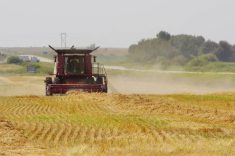If you rely solely on crop protection products to fend off wild oats, you’re not going to like the eventual bottom line.
Herbicide-resistant strains of the weed are going to mean you’ll eventually run out of luck. It’s not a new problem, but every year it gets just a little bit more concerning.
“Resistance is only going to get worse,” warns Kim Brown-Livingston, weed specialist with Manitoba Agriculture.
Read Also

Local farm businesses, groups look forward to Manitoba Ag Days 2026
Most of agriculture is seemingly at Manitoba Ag Days each January: Manitoba agribusinesses and farm groups look forward to connecting with farmers at the 2026 show.
“Without new chemistries coming and with us being reliant on the chemistry that we have, it’s just a matter of time before resistance hits.”
Currently, 69 per cent of wild oats in the Canadian Prairies display some level of herbicide resistance. Of those, 62 per cent are only resistant to Group 1 herbicides, 34 per cent are resistant to Group 2 herbicides, and 27 per cent are resistant to both.
Herbicide resistance, of course, isn’t limited to wild oats. The Manitoba Pulse and Soybean Growers Association lists 14 species known to be resistant to herbicides. But because the available herbicides that work for wild oats are limited to begin with, and because those chemicals that are available have been around for a long time, wild oats have become a bigger problem and tend to get a lot of attention.
“You’re pulling from the same pool of products — the same corner of the chem shed all the time,” Brown-Livingston said.
- [READ MORE] Weeds in fields quickly outpacing crops
While herbicide-resistant wild oats can be found in any field, the problem is particularly acute for cereal crops. Brown-Livingston explains that with a crop like canola, where the majority is either Liberty (glufosinate) tolerant or Roundup Ready (glyphosate tolerant), those chemicals are still effective against wild oats.
“If they’re used properly, then they can actually do a good job,” she says.
Brown-Livingston points out that some pre-emergent chemistries are available for farmers planting cereals, but there tends to be a bit more management involved with these methods and, this year, with the late planting in many areas of Manitoba, that option may not have been available to them.
So, what are the strategies farmers should use when facing these kinds of challenges? In fact, many of the non-chemical approaches to fighting weeds were also hampered by the late seeding this year.
Pre-seeding tillage, which is also used to control weeds, was not feasible for many farmers this year. And since late seeding has given weeds the opportunity to get ahead of the crops, the ability to use crop competition to curtail wild oats is also limited.
Does that mean producers should gear up for a bad year for wild oats?
“Not necessarily,” says Brown-Livingston.
First of all, in-crop spraying is still effective, just not as effective. And while the weeds may have got a head start on the crops, late seeding also means the crops tend to come up more quickly.
“We’ve got warm soils, we’ve got ample moisture and we’re hoping that these crops get up and get going very quickly,” Brown-Livingston said. So, there is still hope for crop competition.
For this year’s crop, at this point, there’s not a lot a farmer can do but apply the in-crop herbicide effectively and according to the label, then just hope for the best. But over the longer term, now is a good time to get a handle on the challenges and take steps to counteract the spread of resistant wild oat.
Keep an eye out for random patches of wild oat in the field. More regular patterns tend to indicate a mechanical problem with the spraying, like clogged nozzles.
If you suspect you have a herbicide-resistant infestation, Brown-Livingston said it’s important to be vigilant and ready to take action, against those patches of wild oat, for example.
“Go in and mow that patch out and do not let that set seed,” she said. “Do not let that seed hit the ground because if it is resistant wild oats and that seed hits the ground, your problem is that much bigger next year and the year after that.”
That vigilance includes thoroughly cleaning the combine or any implements used in that field.
An excellent resource for dealing with wild oats can be found at the Weed Science Society website. It provides advice, strategies and plenty of easy-to-follow infographics to aid farmers in their battle against wild oats. And while some of the strategies may not be much help this year, this problem isn’t going away, so bolstering defences for the future is always advisable.















